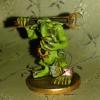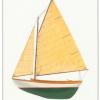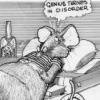-
Posts
162 -
Joined
-
Last visited
Reputation Activity
-
 Small Stuff got a reaction from The Sailor in Mercury by The Sailor - Amati/Victory Models - 1:64 - Russian 20 gun brig
Small Stuff got a reaction from The Sailor in Mercury by The Sailor - Amati/Victory Models - 1:64 - Russian 20 gun brig
What an intresting Brigg, Richard! And with an exiting history! Thanks for sharing. I'll follow!
-
 Small Stuff reacted to Salty Sea Dog in USRC Ranger by trippwj - Corel - 1:64 scale
Small Stuff reacted to Salty Sea Dog in USRC Ranger by trippwj - Corel - 1:64 scale
I did some length on deck measuring on the two plans and worked the scale thing backwards to see how it worked out with Chapelle's descriptions. Using highly nautical terms, I measured the length along the centerline to the raised edge board thingies around the perimeter of the deck. I went to the closest 1/16". In the picture below, the Ranger deck plan is above the yellow yardstick and the Dallas deck plan is below that.
In "The History of American Sailing Ships", Chapelle says the Dallas was a sister ship to the Surprise built to William Doughty's 69'-6" plan (pg 194). I measured 17.25" on the AL Dallas plan and at 1:50, that would be 17.25 divided by .24 = 71.875'. If the scale were really 1:48 instead of the more Euro 1:50, the 17.25 would be divided by .25 = 69' which matches Chapelle's info more closely.
On the Corel Ranger plans, I measured 10-15/16" to the perimeter board thingies. Dividing that by .1875 for the 1:64 scale, that ends up at 58'-4". On page 186, Chapelle describes the Massachusetts as being 58'-6-1/2".
So the Dallas would be the largest tonnage and the Ranger would be the mid-size one. I don't know if this is helps, but it was fun to open the boxes and look stuff over!
-
 Small Stuff reacted to EdT in Young America 1853 by EdT - FINISHED - extreme clipper
Small Stuff reacted to EdT in Young America 1853 by EdT - FINISHED - extreme clipper
Young America - extreme clipper 1853
Part 26 – Forward Half Frames/Ribbands
To provide space for work on the forward cant frames, I deferred setting of the remaining half frames. In the first picture that work is proceeding.
The next picture shows all of the forward frames installed.
The sleek forward hull shape is really visible at this stage. The next picture shows a different perspective.
And another view.
At this stage the alignment and spacing of the frames are set by the softwood spacers between each frame about midway between the keel and topside. More strength is needed for final fairing of the lower hull. Also, as the above photo shows, there is some irregularity in the line of the toptimbers that needs to be corrected before final fairing.
I decided to fair the forward hull before proceeding to the aft frames. To provide additional strength and align the frame tops I installed temporary “ribbands” on both sides at the height of the planksheer. I found this a very useful device in constructing Naiad.
The next picture shows the starboard ribband being fitted.
These were made from single 3/16” strips of clear white pine. One end was boiled to set the curvature and in the above picture is being clamped for drying. In the next picture installation is proceeding.
The strips are secured to every frame by short pins through drilled holes. These are bent over on the inside to pull every frame tightly into the fair line of the ribband. I cut off the points of the pins before bending to avoid all the scratches I got from these while working inside Naiad. The holes in the frames will later be used for sheer strake bolts. The tops of the strips are set at the height of the bottom of the planksheer rail, so these can be used to trim off the tops of the aft upper futtocks.
The next picture was taken from above after the strips were installed.
The center marks on the cross-spales cannot be seen under the thread line. This is a good thing. In addition to this centering check, the outside of the ribband was also checked by squaring up from the base drawing.
In the next picture I cleared all the clutter from the shipway to focus on the lines of the very sharp forward entry.
At this stage the frames have only been given the bevel described earlier before they were set. Some additional sanding to refine the fairness is needed.
The model can now be removed from the base and upended for sanding and also for installation of quite a few bolts, especially those holding the half-frames to the deadwood. These joints are quite weak so the model bolts will have to provide strength. I will cover this in the next post.
Happy Thanksgiving everyone.
Ed
-
 Small Stuff reacted to pete48 in Muscongus Bay Sloop by pete48 - FINISHED - SMALL
Small Stuff reacted to pete48 in Muscongus Bay Sloop by pete48 - FINISHED - SMALL
While I keep adding Varnish to Keel 3 , I started on Keel 4, This one will have a working Retractable Center Board, a working Rudder and I am going to open the frames up in the cabin area. Here are the results
-
 Small Stuff got a reaction from pete48 in Muscongus Bay Sloop by pete48 - FINISHED - SMALL
Small Stuff got a reaction from pete48 in Muscongus Bay Sloop by pete48 - FINISHED - SMALL
Hy Pete,
1/24 - that's really big! Thanks for your answer - I was irritated because there is the word SMALL in the title - but it is a small boat in a large scale ... that sounds to be an intresting idea!
Aren't you affraid of so less moulds and fixingpoints for the planks?
Fine Work you've done! Thanks for sharing.
-
 Small Stuff got a reaction from pete48 in Muscongus Bay Sloop by pete48 - FINISHED - SMALL
Small Stuff got a reaction from pete48 in Muscongus Bay Sloop by pete48 - FINISHED - SMALL
Hello Pete,
I'm following your step from the kit to scratch with great interest.
H.I.Chapelle drawing is a first class source and I like his book about small sailing crafts very much.
I'm very interested in the working rudder... but if the rudder is "alife" (instead of light inside) you can make her RC?
So I'm asking for the scale I guess something like 1/96 or 1/64 - am I right?
-
 Small Stuff reacted to pete48 in Muscongus Bay Sloop by pete48 - FINISHED - SMALL
Small Stuff reacted to pete48 in Muscongus Bay Sloop by pete48 - FINISHED - SMALL
This Is my Second Build log ,( First scratch ) . The plan is to build a Muscongus bay sloop with working rudder and retractable centerboard. This may take 2 boats to get me there. I will be starting this build with Keel #3 . There was a lot of research and comparison"s made to the Midwest kit That I built. Keel # 1 & 2 are on the Kit build log (although keel #2 was built just to get the hull planking correct ) . Keel #3 will also have a planked deck (possibly sprung)
-
 Small Stuff reacted to Timothy Wood in Atlantic 1903 by Timothy Wood - FINISHED - Scale 1/8 = 1' - Half-Hull
Small Stuff reacted to Timothy Wood in Atlantic 1903 by Timothy Wood - FINISHED - Scale 1/8 = 1' - Half-Hull
Just finished about an hours worth of work on the hull with the chisel and wood rasp.
Cheers,
Tim
-
 Small Stuff reacted to michael mott in Bristol Pilot Cutter by michael mott - 1/8 scale - POF
Small Stuff reacted to michael mott in Bristol Pilot Cutter by michael mott - 1/8 scale - POF
John, no.
The inner core is some brass cross bored to accept a couple of small 1/4 inch diameter ceramic magnets the dial is a drawing done in cad I'm still playing with the final design.
The centre is bored out to 1/2 inch diameter.
The base which still need the holes bored for attaching it to the deck, has a 1/8th diameter rod with a dressmakers steel pin cut and glued into the top, At first I just used the pin but the magnets pulled to it , so with just a short piece the magnets are OK. the diameter is 1 3/16 or 9 1/2 in scale.
My silver smith friend had given me a piece of copper that she had drawn into a cup shape on her press the OD is 1 1/4 inches in diameter I had to dome the top a bit because it was rounded but flat in the middle a bit like a copper end cap for plumbing pipe.
I machined up a ring of brass that will get the holes drilled for mounting on the deck and some copper rivets to attach it to the copper.
A rotation to check that it is still working.
placed in front of Arnold who is sitting in the cockpit.
I still need to make the glass cover plate and brass ring. and nameplate.
I know its not fully gimbled, perhaps the next one.
Michael
-
 Small Stuff reacted to Old Collingwood in HMS Greyhound by Old Collingwood - Corel
Small Stuff reacted to Old Collingwood in HMS Greyhound by Old Collingwood - Corel
^^^Thank you very much for taking a look at my build and the references you posted, i have seen the pics of the museum model before, it is basicaly what i am building except i am extending the poop deck a little further to include the mizzan mast, and putting the steps on the edge instead of through the roof.
C.
-
 Small Stuff got a reaction from popeye the sailor in HMS Greyhound by Old Collingwood - Corel
Small Stuff got a reaction from popeye the sailor in HMS Greyhound by Old Collingwood - Corel
Old Collingwood - great work you do! Perhaps these pictures from the NMM 1/48 original model of 1720 may help:
http://upload.wikimedia.org/wikipedia/commons/4/40/Sixth_rate_ship_model_3.jpg
http://upload.wikimedia.org/wikipedia/commons/c/c8/Sixth_rate_ship_model_2.jpg
The systematic number in the NMM is SLR 0411 and you can find good pictures in Robert Gardiner's The Sailing Figat A History In Shipmopdels, too.
I found a drawing about Lyme in Robert Gardiner's The First Frigats Nine-Pounder And Twelve-Pounder Frigates, 1748-1815. You have got this book in your shelf? (Or you may like to use Chapman's well known Plate LV, No.10.. .http://www.sjohistoriska.se/ImageVaultFiles/id_3085/cf_1803/55.JPG )
Edit: http://www.shipwreckworld.com/media/article/images/2008/06/13/118-original-hmsontarioadmiraltydrawing02.jpg
Is the AotS book helpful to you also you built Lyme?
HTH,
yours Stan
-
 Small Stuff reacted to realworkingsailor in SS Stadacona by realworkingsailor - Sylvan Scale Models - 1:87 - Resin/Multimedia - kit-bash
Small Stuff reacted to realworkingsailor in SS Stadacona by realworkingsailor - Sylvan Scale Models - 1:87 - Resin/Multimedia - kit-bash
It may seem strange, but at one time the vessels plying the inland Great Lakes were some of the largest in the world. Even in the mid 20th century, most ocean going freighters settled comfortable around the 500 foot mark, lakers were already into the 700 foot range.
Thanks to the opening of the 4th Welland Canal in 1932, ships of up to 730 feet could make the transit down from the upper lakes (Superior, Huron, Michigan and Erie) to Lake Ontario. At that time, the largest ocean going vessel that could reach the lakes was limited by the locks and canals of the pre-modern seaway. Smaller vessles, known as canallers, would tranship from lakes ports to ports on the lower St. Lawrence river. They were limited to a mere 261 feet long by 40 feet wide and a maximum draft of around 8 or 9 feet. These were small ships, but there were LOTS of them.
In 1959 the current Seaway was opened. This allowed passage of the largest lake vessels (at that time) to the lower river, it also reduced the total number of locks from 28 to 7, between Montreal and Lake Ontario. The old time canaller sailors used to joke, that they would litterally walk from Cornwall to Montreal. This also meant the end of "Canal" sized vessels, as they were no longer efficient in the face of the larger vessels. Aside from specialty ships (cement carriers or package freighters), most canalers were gone by the end of the 1960s. The last unaltered canaller currently sits at Industrial Marine and Salvage in Port Colborne Ontario. The crane ship "D.C. Everest" (1953) was last used as a barge. She now sits awaiting her eventual fate.
Another small update. Have completed the fo'c'sle bulwarks. Made of styrene sheet and strip. Each frame, and the bulwark was made from 0.030" styrene. The flanges and cap rail are all 0.015" x 0.080" styrene strip. I used the moulded on rivets on the hull as a reference for spacing the frames correctly. It will need a little touch up with filler along the bottome outside edge to fill any remaining small gaps and inconsistencies. But otherwise, I'm pleased with the result.
Now it's time to get serious tackling the stern and mid sections and get that hull put together.
Andy
-
 Small Stuff reacted to guillemot in Scottish Maid by guillemot - FINISHED - 1/8" scale - Hall's 1839 Clipper Schooner
Small Stuff reacted to guillemot in Scottish Maid by guillemot - FINISHED - 1/8" scale - Hall's 1839 Clipper Schooner
Some progress, rigging is a very long job when you're intending to add running rigging as well... Starting to look a bit more shipshape now. topmasts added, mast tackles, shrouds....
-
 Small Stuff got a reaction from guillemot in Scottish Maid by guillemot - FINISHED - 1/8" scale - Hall's 1839 Clipper Schooner
Small Stuff got a reaction from guillemot in Scottish Maid by guillemot - FINISHED - 1/8" scale - Hall's 1839 Clipper Schooner
1/96 - what a miniscule work you do - that's great to "sea" . Thanks a lot for sharing this impressions.
-
 Small Stuff reacted to guillemot in Scottish Maid by guillemot - FINISHED - 1/8" scale - Hall's 1839 Clipper Schooner
Small Stuff reacted to guillemot in Scottish Maid by guillemot - FINISHED - 1/8" scale - Hall's 1839 Clipper Schooner
Haven't had a lot of time to work on the ship as this time of year there's all that crap like firewood to be thinking of etc. etc. However...
I've been seeing how small I can turn bullseyes - this one is about 1.5mm. Don't think much smaller is practical. They have a habit of flying off into the ulu... Worth it though as they do look better on the model...
So here's the bowsprit and jb-boom with their standing rigging. Nice to be finally getting on with what makes a sailing ship interesting. Lot of eyestrain to come!
-
 Small Stuff reacted to Old Collingwood in HMS Greyhound by Old Collingwood - Corel
Small Stuff reacted to Old Collingwood in HMS Greyhound by Old Collingwood - Corel
Thanks hamilton, it will certainly be an interesting build, and hopefully my build experience both plastic and wood will come in useful.
On with my build, after offering up forecastle b-head num 1, i soon discovered the slots on both the keel and b-heads where tight, so i opened both up slightly after checking the centre point of the slots, then a nice join was made, i then fitted brace 23s and offered up both number 24s, but as i did with my vic build i decided to fan out these two supports at 45deg angles, first i sanded the edges of both to meet at a point then glued both in place.
I did this because i found it makes for a smoother more natural curve for the hull planking.
Anyway heres the pics.....
C.
-
 Small Stuff reacted to ray111 in Scottish Maid 1839 by ray111 - Artesania Latina
Small Stuff reacted to ray111 in Scottish Maid 1839 by ray111 - Artesania Latina
started planking one side of the hull.






